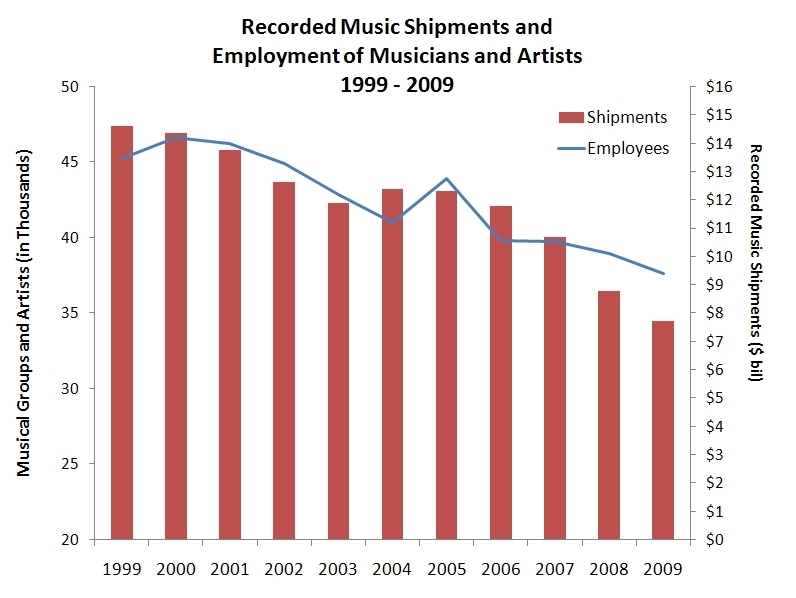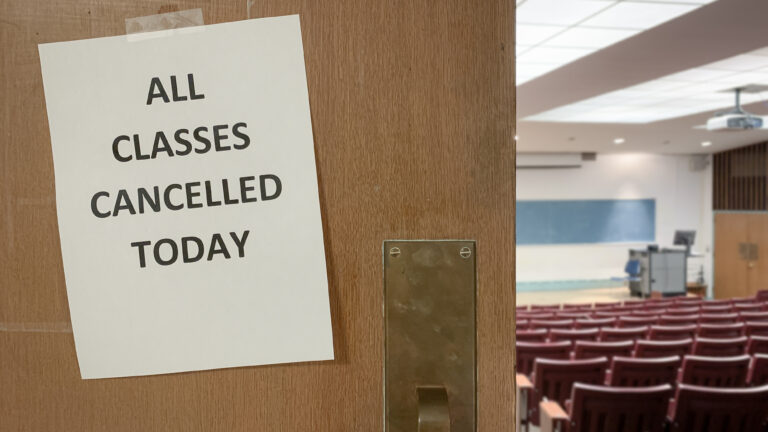Have we lost 41 percent of our musicians? Depends on how you (the RIAA) count (original) (raw)
Have the number of people who call themselves musicians dropped by 41 percent?
He appeared before the Personal Democracy conference in New York City on June 12 of this year. Such was the tension in the audience as Cary Sherman approached the stage that the moderator offered some cautionary words.
"The world changed this winter with the fight over SOPA and PIPA, and everybody is evaluating what that means," his introduction to the guest began. "To some degree it is a cliche; it is a little bit like Daniel entering the lion's den... I also think we owe him the same civility that we would respond to any controversial speaker no matter how controversial their views, so I'm expecting you all to treat him with respect."
With that, the CEO of the Recording Industry Association of America took the podium and, to no one's surprise, inveighed against copyright infringement and piracy. No sparks flew. The audience treated Sherman in a cordial and friendly manner. They even laughed at his jokes, which is probably why his presentation didn't get much immediate news play.
One factoid from the speech, however, has taken on a life of its own. Sherman offered it alongside a chart about 14 minutes into the speech.
"The fact that I think is very interesting, but I think that most people don't know, is that there are fewer people trying to make money as musicians today," he explained.
"According to BLS [Bureau of Labor Statistics] data from the Federal government, the number of people who self describe themselves as musicians has declined since 1999 by 41 percent. Obviously piracy is not just a problem for our economy, but for our culture too."
A difficult reality to stomach
I didn't hear about this revelation at Sherman's talk. Like lots of other tech industry observers, I first learned about it on a Twitter log, mine coming from indie radio station @WFMU in New Jersey: "US Bureau of Labor Statistics:" the @WFMU tweet solemnly declared, "There Are 41% Fewer Paid Musicians Today Than in 1999."
The missive's hyperlink pointed to a post at Digital Music News, founded by former Epic Records marketer Paul Resnikoff.
"There's more music being created than ever before, but paradoxically, musicians are making less," Resnikoff's commentary explained. "Which means there are also fewer musicians and music professionals enjoying gainful employment, thanks to a deflated ecosystem once primed by major labels and marked-up CDs."
"It's a difficult reality to stomach, especially given years of misguided assumptions about digital platforms. But it's not really a revolution if it's not getting people paid. And according to stats supplied by the US Department of Labor, there are 41 percent fewer paid musicians since 1999."
Below this sad declaration came the following chart, which shows a long drop in paid musicians and in recorded music shipment sales, followed by a link to Sherman's presentation.
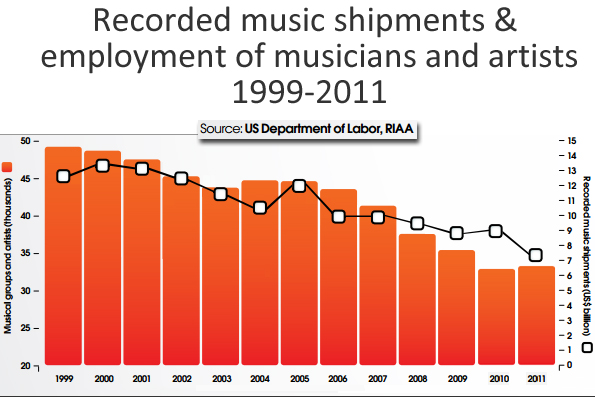
Disturbed by this revelation, I followed the trail of comments stemming from Resnikoff's missive, which quarreled over the ethics of illegal file sharing and the efficacy of various business models. But what struck me was that none of these debaters double checked the arithmetic construed from the table. After all_,_ if you think about it, this is an astounding claim to make: that the United States has lost something approaching half of its paid musicians since 1999.
So I checked the figures myself, using the basic percentage change formula that I was taught in high school (which, admittedly, was a long time ago): (P2 - P1) / P1 x 100 = percentage change.
If you look at the Digital Music News version of the chart, it looks like the orange bar over 1999 comes to about 49,000 "musicians & artists." Let's call that our P1. The orange bar over 2011 comes to around 34,000 or so. That's our P2.
Next, plug in the numbers: 34,000 minus 49,000 equals negative 15,000, that difference divided by 49,000, then multiplied by 100 equals negative 30.6 percent.
In other words: a 30.6 percent decline. To be fair, a 30 percent drop isn't 41 percent, but it is still a big fall. Given the discrepancy, however, I began wondering about the numbers themselves. So I went to the Bureau of Labor Statistics' web site myself. The first and most obvious numbers I found were the Occupation Employment Statistics National Cross Industry figures for "musicians and singers" in 2011 (zip / excel): 42,530, and the OES figures for 1999 (zip / excel): 46,440.
And I ran that formula again.
42,530 (P2) - 46,440 (P1) / 46,440 (P1) x 100 = 8.4 percent decline.
8.4 percent, I'm sure most readers will agree, is a long way from 41 percent.
Working over time
At this point I realized that it was time for me to contact the RIAA itself, and ask them to explain where they got their figures and how they did their math. In response, RIAA executive Jonathan Lamy pointed me to this chart, published on the trade association's blog pages in 2010.
source: RIAA Music Notes [riaa.com]
Credit: RIAA
source: RIAA Music Notes [riaa.com] Credit: RIAA
His e-mail cc'ed RIAA marketing expert Josh Friedlander. "Josh tells me that particular BLS data comparison of July '99 vs August 2011 yields 41% decline," Lamy wrote.
This table (above) is somewhat different from the Digital Music News display. Aside from the fact that it doesn't mention 2011 (having been produced a year earlier), it reverses the graphics indicators for "musicians and artists" (they're now declining in linear rather than orange bar fashion). But by my simple percentage change formula, the descent is fairly mild. If there were 45,000 "musicians and artists" in 1999 and about 39,000 in 2009, the drop comes to about 13.33 percent.
So I wrote to RIAA yet again. How did you produce 41 percent, and where did you get your data figures? (After all, I was looking at "musicians and singers" and they said they were tracking "musicians and artists.").
"As far as the 41%, from that data set," came Friedlander's reply, "if you look at any of a variety of months between late 1999 and 2011 and 2012 (such as July '99 vs Aug '11) you can see declines around the 41% level (different months yield different figures, but some are even higher than 41%)."
As for the data, I was told that they came from North American Industry Classification System categories. NAICS is basically a cross agency/industry system for studying sectors of the North American economy.
"Although I don't know if anyone outside the agency can call themselves experts on Bureau labor data," Friedlander explained, "my understanding is that the occupational statistics you link to below are simply a different way of looking at the same underlying data that I used characterized by the industry NAICS codes. I think the NAICS codes provide better aggregation across fields, while the OES charts break out the data in a way that is more difficult to work with over time."
Indeed, the BLS advises statisticians that the OES figures I used should be taken with a grain of salt, in large part because job classifications keep changing as industries change.
For example: "Workers in newly classified occupations, such as systems software engineers and applications software engineers, may have been reported as computer programmers in the past," BLS warns. "Therefore, even occupations that appear the same in the two systems may show employment shifts due to the addition or deletion of related occupations."
But in 2002, the BLS transitioned to the very NAICS classification system that RIAA says that it used. So I plugged in the national estimates for "musicians and singers" for that year up to 2011, a pretty solid chunk of time. 53,940 for 2002; 42,530 for 2011. That gave me a 21 percent decline.
Not either/or
I decided to show RIAA some of my numbers and press for more details on theirs' one more time.
"You are looking at YEAR vs. YEAR," came the reply. "Please read Josh's note closely: we looked at MONTHLY data: one month in a year vs. another month a year. Comparison between July '99 vs. August 2011. What you find AND what we said can BOTH be right. It's not either/or. It depends on what date you compare."
The problem with this response was that Sherman's categorical statement that we've seen a 41 percent drop in the number of musicians and artists since 1999 wasn't based on a monthly chart. It was based on the yearly table that he showed the Personal Democracy conference.
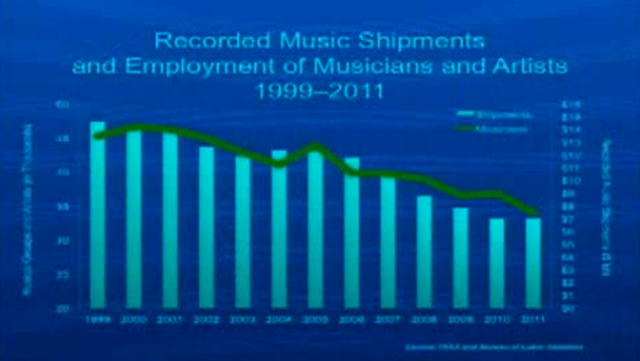
It's hard to make out the figures on this screenshot from Cary Sherman's presentation at the Personal Democracy conference. But the chart clearly tracks job decline in years, rather than months. Credit: http://www.youtube.com/watch?v=mSUsiVnvS2w&feature=youtu.be
But the second part of RIAA's response is spot on. Both the RIAA and I could be right. More likely: we could both be wrong. It would be irresponsible for me to conclude that, based on my earlier mentioned OES figures and personal calculations, the US has seen a decline in musicians and singers of "only" 8.4 percent. Equally dubious is the assertion that the drop came to 41 percent, "according to BLS data"—not to mention the corollary assertion that the fall, whatever the percentage, can be clearly linked to illegal downloads.
In the end, there is just too much conflicting information to produce a single, simple sound bite or tweet quality number. That's why the Bureau of Labor Statistics puts all its occupation related tables on its archives page—so that social scientists will see the variant ways in which jobs and professions have been tracked over the last decade.
> 17,000 musicians needed
It is worth ending this cautionary tale with a review of the BLS's own occupational handbook projection for musician/singer employment in the near future. Note that the handbook cites a much higher employment figure for both trades in 2010 than mentioned in the above tables: about 176,200 musicians and singers. That's because it comes from the Bureau's National Employment Matrix, I was told, which adds additional data sources.
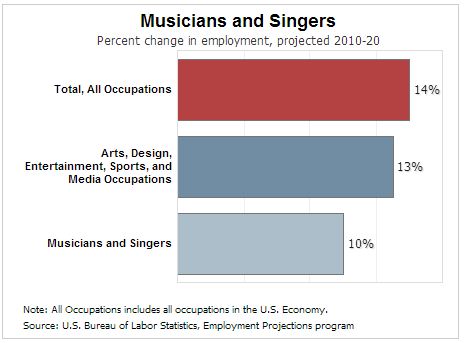
Employment for musicians and singers is expected to grow by ten percent over the decade—"about as fast as the average for all occupations," the government notes:
The number of people attending musical performances, such as orchestra, opera, and rock concerts, is expected to increase from 2010 to 2020. As a result, more musicians and singers will be needed to play at these performances.
There will be additional demand for musicians to serve as session musicians and backup artists for recordings and to go on tour. Singers will be needed to sing backup and to make recordings for commercials, films, and television.
It's not all good news. "Growth will likely be limited as orchestras, opera companies, and other musical groups have difficulty getting funding," the agency warns. And although some musicians will work for non-profits or seek corporate sponsorships, "during economic downturns, these organizations may have trouble finding enough funding to cover their expenses."
A very mixed bag, but the summary does not mention the impact of illegal downloading anywhere. "Musicians and singers with exceptional musical talent should have the best opportunities," the assessment concludes.
Matt writes for Ars Technica about media/technology history, intellectual property, the FCC, or the Internet in general. He teaches United States history and politics at the University of California at Santa Cruz.
